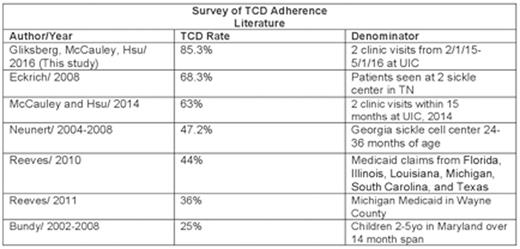Abstract
Background:
TranscranialDoppler ultrasound (TCD) screening for stroke risk is one of the major advances in pediatric sickle cell disease, since the landmark STOP study. TCD screening is among the measures for quality of pediatric sickle cell care proposed by expert consensus (Wang 2011, NHLBI guidelines 2014). Reeves et al 2016 shows that TCD screening rates are low but still improving (22% in 2006 -44% in 2010). To improve the quality-of-care provided to pediatric sickle cell patients at University of Illinois Hospital, we conducted chart review in 2014 to establish a baseline report of UI Hospitalsadherence to the expert care standards. At that time TCD screening rates were much lower than immunization rates. We then introduced a reminder table in the electronic medical record. 18 months since this change in EMR we re-evaluated our compliance with TCDs.
Objectives:
To evaluate the improvement atUIHealthpediatric sickle cell clinic compliance with annual TCD.
Methods:
A manual chart review of these pediatric sickle cell patients was employed to determine adherence to TCD screening standards. All patients ages 2-16yowith SCD-SS and SCD-S/Beta-0-thalassemia that were seen in pediatric sickle cell clinic and adolescent-adult transition clinics two times over 15 months from 2/1/15-5/1/16 were included in study. TCD compliance was determined if patient had TCD between 5/1/2015 through 5/31/16. 5-15 minutes per patient was spent evaluating EMR for TCD compliance
Data from the 2014 previous study was also re-evaluated using the same criteria of 2 visits within 15 months of original study date and TCD within 1 year of study.
Results:
In this work, the charts of 91 pediatric SCD-SS and SCD-S/Beta0 patients were reviewed (ages 2-16 years; M: 34 F 28, 5 ineligible [2 on chronic transfusion, 1 high hemoglobin, 1 yearly MRI, 1 last visit before 2yo]. Lost to follow-up (Seen in clinic since 2014 but not 2 visits from 2/1/15-5/1/16): 24 The rate of TCD screening among these eligible children was 53 out of 62, or 85.5% in 2016. Comparable figures from the 2014 chart review were 17 out of 27, or 63% in 2014. Fishers exact test indicates that this was a significant improvement, p=0.05.
Conclusions:
We focused our quality-improvement efforts onTranscranialDoppler screening, adding a reminder table in the Electronic Medical Record then re-assessing 18 months later. The rate of TCD screening significantly improved from 63% to 85%. Although less than 100%, these compare favorably to other published TCD rates (Table). The next step is to improve clinic attendance and tracking, to reduce the rate of patients who are "lost to follow-up." To facilitate future chart reviews we have incorporated the key parameters into our "Screening & Management Table" as a component of the electronic medical record.
Hsu:Purdue Pharma: Research Funding; Mast Therapeutics: Research Funding; Eli Lilly: Research Funding; Sancilio: Research Funding; Centers for Medicare and Medicaid Innovation: Research Funding; Pfizer: Consultancy, Research Funding; EMMI Solutions: Consultancy; Gerson Lehman Group: Consultancy; Astra Zeneca: Consultancy, Research Funding; Hilton Publishing: Consultancy, Research Funding.
Author notes
Asterisk with author names denotes non-ASH members.


